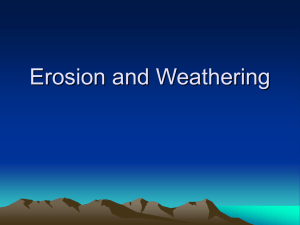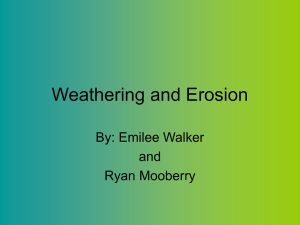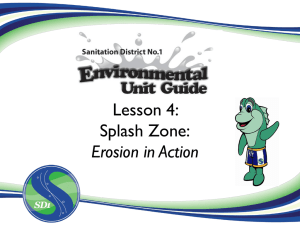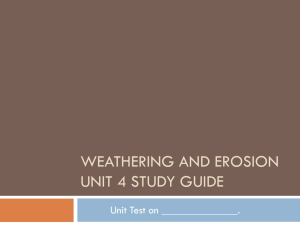and View
advertisement
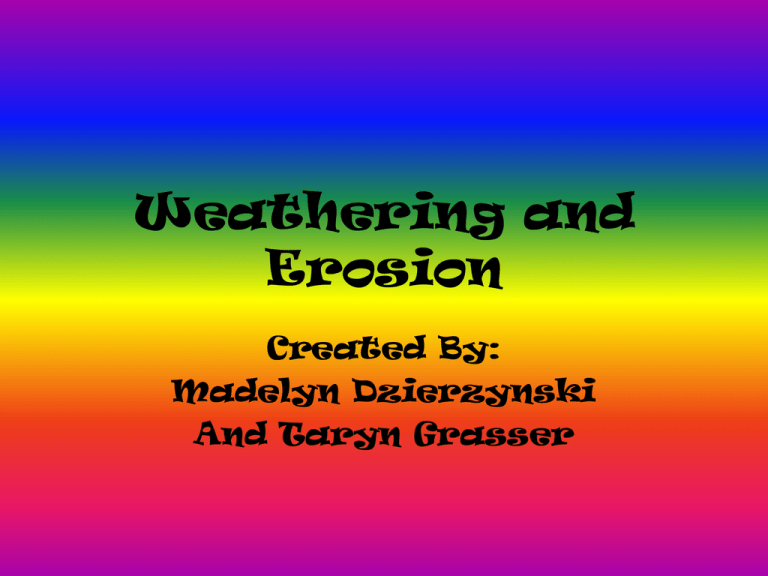
Weathering and Erosion Created By: Madelyn Dzierzynski And Taryn Grasser Weathering • Weathering is the breaking down of rocks, soil, and minerals as well as artificial materials through contact with the Earth’s atmosphere, biota, and waters. Erosion • Erosion is the process by which soil and rock are removed from the Earth’s surface by natural process such as wind, or water flow, and then transported and deposited in other locations. Pictures of Different Types of Weathering Pictures of Weathering and Erosion Causes of Weathering and Erosion • The suns heat causes surface rocks to expand, fracture, and to get moisture on the rocks that can evaporate. Factors Controlling the Rate of Erosion • It is impossible to play-down the importance of preventing soil erosion, but like many problems before you can address it you first have to understand it. USGS- Difference Between Erosion and Weathering • Weathering involves two processes that often work in concert to decompose rocks. Erosion is the process by which soil and rock are removed from the Earth’s surface by natural processes. Soil Erosion • Soil Erosion by water, wind tillage effects both agriculture and the natural environment. Soil loss, and its associated impacts, is one of the most important of today’s environmental problems. Study of Historic Hopi Buttes Area • This project examines land use, climatic variability, and their related impacts on land surface conditions in the ecologically sensitive Hopi Buttes region of the Navajo Nation. Erosion in the Southwest • Erosion is carving into Southwest Washington Beaches. In recent decades, new erosion hot spots have developed. Erosion is also cutting into Cape Disappointment State Park up to 90 camp sites could be lost. Coastal Erosion Prevention • Coastal erosion is a global problem. On the Alaskan coast, it amounts to 45 feet per year. However, there are measure that can prevent coastal erosion. Coastal structures are used in coastal defense schemes with the objective of preventing shoreline erosion and flooding of the adjacent coastal areas. Wind Erosion Prevention Wind erosion happens when the soil is left unprotected from the strong winds. The loss of topsoil lowers the quality of the soil. Beach Erosion Prevention Study • Recognizing the importance of the state's beaches, the Florida Legislature in 1986 adopted a posture of protecting and restoring the state's beaches through a comprehensive beach management planning program • Geologic Hazards: Landslides • Landslides constitute a major geologic hazard because they are wide spread, and they occur in all 50 states and U.S. territories, and cause $1-2 billion in damages and more than 25 fatalism on average each year. Federal Emergency Management Agency Landslides and Mudflows • Even if you feel you live in a community with a low risk of flooding, remember that anywhere in rains, it can flood. Expansion of urban and recreational developments into hillside areas leads to more people that are threatened by landslides each year. Solution • Vegetation is a key factor in erosion prevention, particularly on steep slopes. Retaining native trees, shrubs and grasses on a site that is being developed can greatly reduce future erosion damage, and offset the cost of preserving them. Conserving a natural wetland, within or next to a new development, an provide valuable storm water detention, which helps to prevent flood damage. Soil that has been compacted by heavy pedestrian traffic is more prone to erosion. Well built trails, set back from the edge of streams, can minimize this problem. CONTINUED----- Solution • Reducing impervious surfaces is very helpful for preventing erosion damage in streams, as volume of runoff is thud greatly reduced. There are many agriculture practices that reduce erosion damage and limit the loss of valuable topsoil. Bibliography • • • • • • • • • • • • • • • http://en.wikipedia.org/wiki/Weathering/ http://en.wikipedia.org/wiki/Erosion/ http://facstaff.gpc.edu/~pgore/geology/geo101/weather.htm http://science.nationalgeographic.com/science/photos/weathering-erosiongalary.html#baffin-island http://google.com http://geo.ua.edu/intro03Eros.html http://geomaps.wr.usgs.gov/parks/misc/gweareo.html http://soilerosion.net/ http://esp.cr.usgs.gov/hopibuttes/ http://www.ecy.wa.gov/programs/sea/coast/erosion/study.html http://www.advancedcoastaltechnology.com/ http://www.enviroment.ualberta.ca/SoilPosters/wind.cfm http://www.s-t.com/daily/05-01/05-01-01/c06sp113.htm http://landslides.usgs.gov/ http://www.fema.gov/hazard/landslide/index.shtm Thanks For Watching! Hope You Enjoyed!



